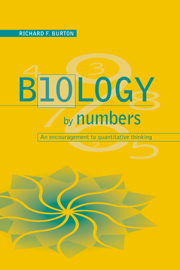Book contents
- Frontmatter
- Contents
- Preface
- A guide to the book
- 1 Putting two and two together
- 2 Units, formulae and the use of old envelopes: confronting some obstacles to quantitative thinking
- 3 Aspects of energy metabolism
- 4 Getting things in proportion
- 5 Perilous percentages, dangerous ratios
- 6 Building a trophic pyramid
- 7 Sodium in animals and plants
- 8 Exchanges of water and carbon dioxide
- 9 A geometric series
- 10 Introduction to logarithms
- 11 Bringing logarithms to life
- 12 Exponential relationships
- 13 Aspects of allometry
- 14 More on allometry, and on quantitative patterns in nature
- 15 How the abundance of food affects rates of feeding
- 16 The characterization of trees and other branching systems
- 17 Epilogue
- References
- Notes
- Index
16 - The characterization of trees and other branching systems
Published online by Cambridge University Press: 05 June 2012
- Frontmatter
- Contents
- Preface
- A guide to the book
- 1 Putting two and two together
- 2 Units, formulae and the use of old envelopes: confronting some obstacles to quantitative thinking
- 3 Aspects of energy metabolism
- 4 Getting things in proportion
- 5 Perilous percentages, dangerous ratios
- 6 Building a trophic pyramid
- 7 Sodium in animals and plants
- 8 Exchanges of water and carbon dioxide
- 9 A geometric series
- 10 Introduction to logarithms
- 11 Bringing logarithms to life
- 12 Exponential relationships
- 13 Aspects of allometry
- 14 More on allometry, and on quantitative patterns in nature
- 15 How the abundance of food affects rates of feeding
- 16 The characterization of trees and other branching systems
- 17 Epilogue
- References
- Notes
- Index
Summary
The total amount of air that enters the trachea is equal to that in the number of stages generated from its branches, like a plant in which each year the total estimated size of its branches when added together equals the size of the trunk.
Leonardo da VinciTo characterize shapes of fruits and to compare fruits of different sizes by means of a few well-chosen measurements can be straightforward (as with the gourds of Section 13.3), but how does one quantify the shape of a tree? How many orders of branch are there, on average, from main trunk to finest twigs? How much narrower, typically, is one branch than the wider one from which it grows? How do younger branches compare in length with older ones? What about the angles of branching? One may approach such questions from the point of view of biomechanics – mindful therefore of the need for each branch to support, with economy of materials, everything that grows from it. Alternatively, one may be interested in the flow of materials, and hence in the cross-sectional areas or resistances of conducting tissues at each level of branching.
What makes this general problem particularly interesting is the fact that it pertains to many kinds of tree-like or branching structures. Indeed similar mathematical treatments have been applied to bifurcating systems as diverse as blood vessels, bile ducts, mammalian airways (bronchial trees) and river drainage systems.
- Type
- Chapter
- Information
- Biology by NumbersAn Encouragement to Quantitative Thinking, pp. 199 - 204Publisher: Cambridge University PressPrint publication year: 1998



